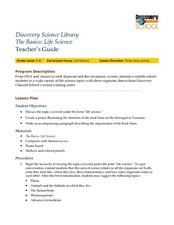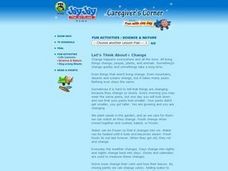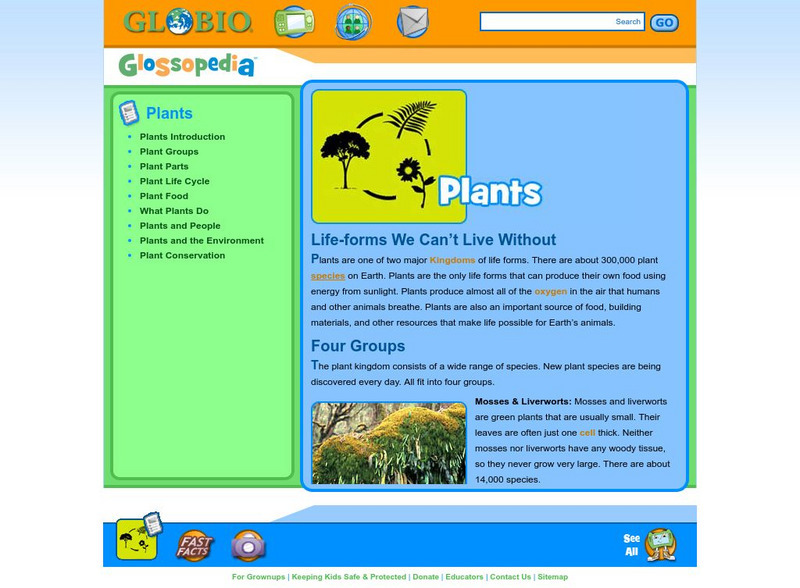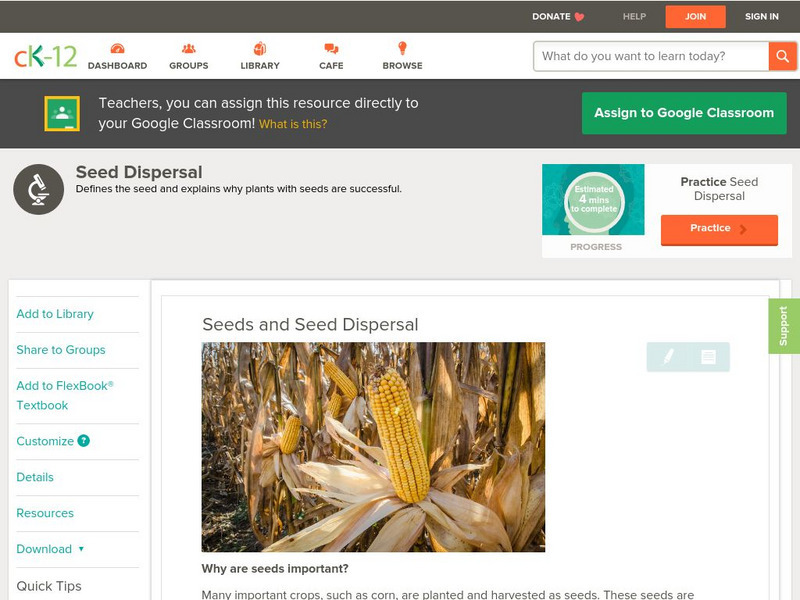Curated OER
Arbor Day Challenge: Crossword Puzzle
In this Arbor Day crossword puzzle, students use a set of 28 clues given at the bottom of the page to complete the puzzle; clues are related to Arbor Day.
Curated OER
How Does Your Garden Grow?
Second graders view an animated picture book at a Web site. The picture book illustrates each step in planting and growing a garden. They design how-to books showing the process. They will draw a picture and write a caption for each step.
Curated OER
The Basics:Life Science
Students explore concepts in life science using segments drawn from Discovery Channel. In this life science lesson, students participate in discussions about the food chain. Students create a poster to illustrate a predator and prey...
Curated OER
Floristic Relay
Fifth graders identify the role succession plays in the adaptation of our environment. Students identify pioneer and climax species and order habitats in succession. They recognize that different characteristics of species make them...
Curated OER
Sugar and Light
Students connect starch to sugar as the storage form of energy. They find that no starch is produced in the plant without light. Students perform the old favorite of looking at starch deposition in geranium leaves using Lugol's iodine...
Curated OER
Little Bloomers: Gardening With Trees
Learners identify the parts of tree flowers. They examine the role they have in pollination. They discuss trees that do not flower as well.
Curated OER
Let's Think About... Change
Students observe various examples of "change." They mix paint to cereate new colors, eat bread and then toasted bread, and match baby pictures with pictures of how the same people look in the present. Finally, they watch a bouquet of...
Curated OER
A TOUGH NUT TO CRACK
Based on a set of criteria, students will evaluate the quality of pecans.1. Bring a gram scale and papershell pecans. Provide five pecans for each student. 2. Divide the class into groups of five and provide each member with five pecans....
Curated OER
Dig Magazine Archeology Quiz #106
In this Dig Magazine archeology quiz, students answer 12 multiple choice questions complementing the October 2009 issue. Page contains answer and additional resources link.
Curated OER
Winer Survival
Students study how animals need water, food, shelter, and space to survive. They also study what animals need to survive in the winter. They play the part of animals and winter "threats" in a game of tag to reinforce concepts.
Curated OER
Enzymes in Action: An Inquiry Approach to the Effects of Enzymes
Students experiment with enzymes as key components of chemical reactions in all living things through this series of lessons.
Curated OER
It's Okay if You Sit on My Quilt Book
Students create a variety of quil blocks to create a unique pieced quilt top during every class. Based on the book It's Okay if You Sit on My Quilt. Students create a quilt block after each lecture.
Curated OER
The Sum of the Parts
Second graders observe some everyday common objects in order to attempt to learn about simple systems and how they fit together. They observe small details in order to identify the parts of a whole design.
Science Buddies
Science Buddies: Gone With the Wind: An Experiment on Seed and Fruit Dispersal
If you have ever made a wish and blown the fluff of a dandelion, you have witnessed how some plants are adapted to spreading their seeds using the wind. The tiny, furry parachute allows the seeds to be picked up by the wind and to be...
Globio
Glossopedia: Plants
Plants are one of the two major Kingdoms of living creatures on the Earth. They are the only beings which produce their own food. Additionally, plants are necessary for animals to live. Plant anatomy, life cycle, reproduction and the...
Utah Education Network
Uen: Seed House
Students will communicate in oral, artistic, written and nonverbal form as they study seeds and their growth. Students will plant seeds, make observations about the seeds' growth, and report their observations to peers .
Children's Museum
The Children's Museum of Indianapolis: Plants Alive: Garden in a Glove Journal
Students will observe the germination and growth of plants from seeds over the course of several days, and record their observations in a journal.
Unite for Literacy
Unite for Literacy: Plants and Food: Dandelion Days
Read about the life cycle of dandelions from their first appearance in the spring. Includes audio narration in 16 additional languages with text in English.
CK-12 Foundation
Ck 12: Life Science: Seeds and Seed Dispersal
[Free Registration/Login may be required to access all resource tools.] Plants seem to grow wherever they can. How? Plants can't move on their own. So how does a plant start growing in a new area? Learn more about seeds and seed...
CK-12 Foundation
Ck 12: Life Science: Vascular Seedless Plants
[Free Registration/Login may be required to access all resource tools.] Vascular seedless plants have vascular tissue but do not have seeds. Most of the large vascular seedless plants from ancient times are now extinct, but their smaller...
Other
Science and Kids Activities: Pollination and Seed Dispersal
Second graders learn how plants depend on animals to disperse their seeds. Students will learn about ways that animals can disperse seeds. They will design their own model and compare it to the real action of plants and animals. In the...
HotChalk
Hot Chalk: Lesson Plans Page: Kick Off Seed Explorations
This simple lesson plan is designed to have young students become more familiar with fruit seeds by identifying fruit that contains seeds/no seeds, gathering seeds from fruit, explaining the importance of seeds, explaining that seeds...
PBS
Pbs Teachers:a Model of Seed Dispersal
Investigate propagation systems in plants, and explain the ways some animals disperse seeds through their digestive processes. Role-play and map the daily travels of one seed-bearing animal to explore the migration of seeds.
























